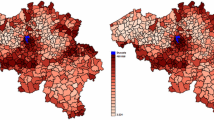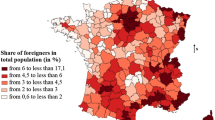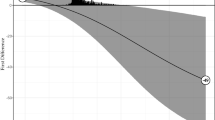Abstract
This paper exploits a Danish spatial dispersal policy on refugees, which can be regarded as a natural experiment to investigate the influence of regional factors on recent immigrants’ location choices. The main push factors are lack of co-nationals and immigrants. Additional push factors are lack of rental, including social, housing and lack of institutions for qualifying education, which explain why recent immigrants are attracted to large cities. Finally, placed refugees tend to leave locations with relatively high regional unemployment, and there is indirect evidence of welfare seeking.





Similar content being viewed by others
Notes
Until June 2002, Denmark gave asylum to Convention refugees, i.e. persons who were defined as refugees according to the Geneva Convention from 1951, and to foreigners who were not defined as refugees according to the Geneva Convention, but who for similar reasons as stated in the Convention or other weighty reasons should not be required to return to the home country (de facto refugees; Coleman and Wadensjö 1999, 249).
To facilitate local refugee reception, the Council made an effort only to place one or two different nationalities in small municipalities, whereas larger municipalities would be assigned more nationality groups of refugees.
This is backed by statistics from the Council, which show that in 1993, 33% of refugees and 26% of the Danish population lived in the capital or its suburbs, while 71% of non-western immigrants lived there. Fifty six percent of refugees and 59% of the Danish population lived in towns outside the capital as opposed to only 24% of non-western immigrants. The remaining shares lived in rural districts (Danish Refugee Council 1993).
On average, a refugee lived in temporary housing 6–7 months after dispersal to a county, but the duration depended on the local housing market situation. Only 0–4% had not found permanent housing within the introductory period of 18 months (Annual reports of the Danish Refugee Council 1986–1996 and internal administrative statistics of the Danish Refugee Council 1992–1997).
The Kaplan–Meier empirical hazard rate for a given month after assignment is calculated as the proportion of refugees at risk of moving out of the municipality of assignment in a given month who actually move. Refugees at risk of moving in a given month are refugees who are observed still to live in the municipality of assignment.
The large drop in the percentage of refugees who initially lived in the Greater Copenhagen area occurred already in 1985 because of the dramatic increase in the number of new refugees in 1985, which made it increasingly difficult for the Danish Refugee Council to find housing for new refugees in the Greater Copenhagen area.
The full set of estimation results is available on request.
References
Åslund O (2005) Now and forever? Initial and subsequent location choices of immigrants. Reg Sci Urban Econ 35:141–165
Bartel A (1989) Where do the new immigrants live? J Labor Econ 7(4):371–391
Bauer T, Epstein G, Gang IN (2002) Herd effects or migration networks? The location choice of Mexican immigrants in the US IZA Discussion Paper 551
Bauer T, Epstein G, Gang IN (2005) Enclaves, language and the location choice of immigrants. J Popul Econ 18(4):649–662
Borjas GJ (1999) Immigrants and welfare magnets. J Labor Econ 17(4):607–637
Bowles S (1970) Migration as investment: empirical tests of the human investment approach to geographical mobility. Rev Econ Stat 52(4):356–362
Chiswick BR, Miller PW (2005) Do enclaves matter in immigrant adjustment? City Community 4(1):5–35
Coleman D, Wadensjö E (1999) Indvandringen til Danmark. Internationale og nationale perspektiver. Spektrum, Viborg
Damm AP (2005) The Danish dispersal policy on refugee immigrants 1986–1998: a natural experiment? Aarhus School of Business: Department of Economics Working Paper 05–03
Danish Refugee Council (Dansk Flygtningehjælp) (1986–1994) Annual Reports 1986–1994
Danish Refugee Council (Dansk Flygtningehjælp) (1993) Om geografisk spredning af asylansøgere, flygtninge og indvandrere. Internal report written by Bente Bondebjerg and Morten Iversen
Edin P-A, Fredriksson P, Åslund O (2003) Ethnic enclaves and the economic success of immigrants—evidence from a natural experiment. Q J Econ 118(1):329–357
Elbers C, Ridder G (1982) True and spurious duration dependence: the identifiability of the proportional hazard model. Rev Econ Stud 49:403–410
Ham JC, Lalonde RJ (1996) The effect of sample selection and initial conditions in duration models: evidence from experimental data on training. Econometrica 64(1):175–205
Heckman J, Singer B (1984) A method for minimizing the impact of distributional assumptions in econometric models for duration data. Econometrica 52(2):271–320
Jaeger DA (2000). Local labor markets, admission categories and immigrant location choice. Working Paper, Department of Economics, Hunter College, NY
Kobrin FE, Speare A (1983) Outmigration and ethnic communities. Int Migr Rev 17:425–444
Lancaster T (1979) Econometric methods for the duration of unemployment. Econometrica 47:939–956
Lee E (1966) A theory of migration. Demography 3(1):47–57
McFadden D (1973) Conditional logit analysis of qualitative choice behavior. In: Zarembka P (ed) Frontiers of econometrics. Academic, New York, 105–142
Ministry of Internal Affairs (Indenrigsministeriet) (1996) Udlændinge ‘96. En talmæssig belysning af udlændinge i Danmark. Ch. 6
Ministry of Internal Affairs (Indenrigsministeriet) (1999) Udlændinge ‘98. En talmæssig belysning af udlændinge i Danmark
Piore MJ (1979) Birds of passage: Migrant labor and industrial societies. Cambridge University Press, Cambridge
Sjaastad LA (1962) The costs and returns of human migration. J Polit Econ 70:80–93
Statistics Denmark (1997) Statistisk Årbog 1997. Statistical Yearbook. Statistics Denmark, Copenhagen
Vaupel JW, Manton KG, Stallard E (1979) The impact of heterogeneity in individual frailty on the dynamics of mortality. Demography 16:439–454
Zavodny M (1997) Welfare and the locational choices of new immigrants. Federal Reserve Bank of Dallas Economic Review. Second Quarter 1997
Zavodny M (1999) Determinants of recent immigrants’ locational choices. Int Migr Rev 33:1014–1030
Acknowledgement
I thank the National Centre for Register Research, the Ministry for Refugee, Immigration and Integration Affairs and the Institute of Local Government Studies for support to access administrative register data from Statistics Denmark. In addition, I thank Bente Bondebjerg and Morten Iversen, Danish Refugee Council, for valuable information about the Danish Dispersal Policy 1986–1998 and Michael Rosholm, Peter Fredriksson and three anonymous referees for helpful suggestions.
Author information
Authors and Affiliations
Corresponding author
Additional information
Responsible editor: Klaus F. Zimmermann
Appendix
Appendix
Rights and permissions
About this article
Cite this article
Damm, A.P. Determinants of recent immigrants’ location choices: quasi-experimental evidence. J Popul Econ 22, 145–174 (2009). https://doi.org/10.1007/s00148-007-0148-5
Received:
Accepted:
Published:
Issue Date:
DOI: https://doi.org/10.1007/s00148-007-0148-5






